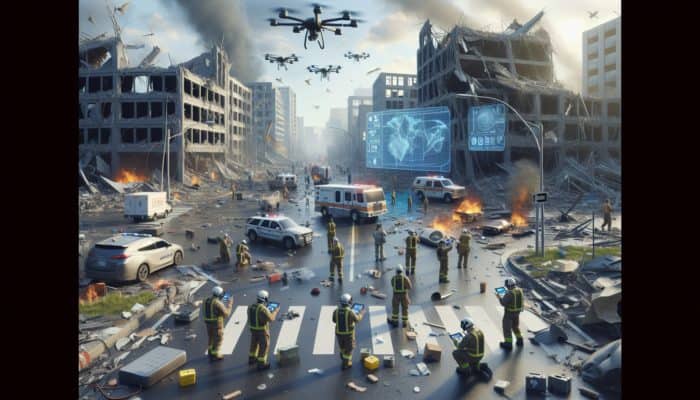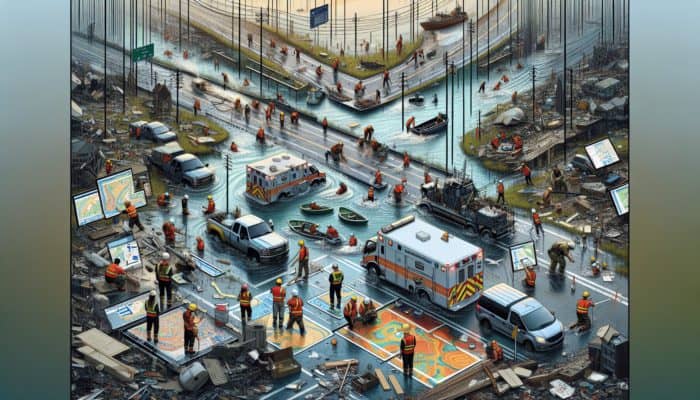Mastering Navigation Strategies in Post-Disaster Scenarios
What Constitutes Post-Disaster Navigation?

Post-Disaster Navigation: Post-disaster navigation involves a comprehensive set of methods and tools designed to traverse and effectively manage areas following a catastrophic event, thereby prioritising safety and operational efficiency. This crucial aspect of disaster management ensures that both responders and affected individuals can successfully navigate through treacherous environments. The key elements of post-disaster navigation encompass:
- Assessment of impacted regions
- Mapping out safe transit routes
- Identification of critical resources and services
- Coordination with emergency service personnel
- Utilisation of technology for real-time situational awareness
- Community engagement and harnessing local knowledge
- Training and preparedness initiatives
These components synergistically form a robust navigation framework that can evolve according to the unpredictable conditions typical of post-disaster scenarios. By ensuring that all responders are equipped with the necessary tools and information, the probability of successful navigation and effective recovery is significantly enhanced.
What Technologies Are Pivotal in Post-Disaster Navigation?
Technological advancements have significantly enhanced the effectiveness of post-disaster navigation. A variety of tools enable responders to assess situations, chart routes, and communicate efficiently and rapidly. The technologies that are integral to the navigation process include:
- Global Positioning Systems (GPS) for precise location tracking
- Drones for conducting aerial mapping
- Satellite imagery for comprehensive terrain analysis
- Mobile applications for real-time updates and information
- Geographic Information Systems (GIS) for advanced data visualisation
- RFID tags for effective tracking of resources
- Emergency communication systems for reliable connectivity
These technologies facilitate the rapid evaluation of disaster-stricken regions, supplying critical insights that can significantly influence decision-making processes. For example, drones can offer aerial perspectives of inaccessible areas, while GIS technology aids in analysing spatial data to ascertain the safest evacuation routes or resource distribution pathways.
Why Is Accurate Mapping Crucial for Navigation?
Accurate mapping serves as a fundamental pillar for effective post-disaster navigation, as it enables the identification of secure routes and essential locations, such as shelters, hospitals, and supply depots. In many cases, outdated or incomplete maps can lead to perilous miscalculations. For instance, during the aftermath of the 2010 earthquake in Haiti, the deployment of updated mapping technologies enabled relief agencies to pinpoint individuals who were stranded and urgently needed assistance.
Furthermore, sophisticated mapping methodologies such as LiDAR and remote sensing have been instrumental in producing detailed topographic maps that illustrate terrain alterations caused by disasters. These maps are not only vital for navigation but also crucial for effective recovery planning. The insights gained from these mapping efforts have catalysed the creation of superior practices in post-disaster navigation, underscoring the importance of precision and real-time data in disaster response.
Identifying and Overcoming Challenges in Post-Disaster Navigation

What Are the Common Challenges Faced?
Navigating through post-disaster landscapes presents numerous challenges. Frequent obstacles include severely damaged infrastructure, communication breakdowns, and a lack of real-time data. Infrastructure may suffer extensive damage, with roads obstructed, bridges rendered unusable, and buildings collapsed, making conventional navigation methods not only ineffective but also hazardous.
Communication barriers further complicate recovery efforts. Following disasters, cellular networks may become non-operational, and traditional communication methods can quickly lose reliability. Additionally, the absence of real-time data can result in significant delays in response times, hindering navigators’ abilities to make informed decisions. These hurdles necessitate the implementation of innovative and adaptive strategies to ensure safe navigation and effective responses in areas devastated by disasters.
How Can Communication Barriers Be Addressed?
Effective communication is paramount for coordinating navigation efforts during and after a disaster. To overcome communication barriers, various strategies can be implemented. The use of satellite phones ensures that individuals can maintain contact, regardless of the reliability of local cellular networks. Establishing temporary communication networks, such as mesh networks or enlisting the help of amateur radio operators, can facilitate the exchange of information among responders.
Moreover, training individuals in emergency communication protocols can greatly improve coordination during crises. Community workshops on emergency communication techniques can foster resilience and ensure that residents are well-equipped to disseminate information effectively. By harnessing technology and community resources, communication gaps can be effectively bridged, allowing for more efficient navigation and response efforts.
How to Navigate Infrastructure Damage Effectively?

Infrastructure damage poses a significant barrier to navigating the aftermath of disasters. Responders must often identify alternative routes when primary roads become impassable. Leveraging technology, such as GPS and mapping applications, can help uncover alternative paths that may not be immediately visible.
Temporary solutions, such as deploying portable bridges or using ferries in flood-affected areas, can facilitate movement across compromised landscapes. Collaboration with local authorities and agencies can provide invaluable insights into the current state of infrastructure, enabling navigators to adapt their strategies in real-time. By emphasising adaptability and resourcefulness, navigators can effectively manage the challenges presented by infrastructure damage during disaster scenarios.
What Role Does Real-Time Data Play in Navigation?
Real-time data significantly enriches post-disaster navigation, furnishing critical insights into current road conditions and potential hazards. Technologies that deliver immediate information, such as traffic monitoring systems and drone imagery, play a pivotal role in enhancing situational awareness.
For instance, in the wake of Hurricane Harvey in 2017, responders harnessed real-time data to evaluate flooding conditions and adjust team deployments accordingly. By integrating multiple data sources, navigators can effectively plan routes that prioritise safety and efficiency. This data-driven approach facilitates informed decision-making and agile responses to the rapidly changing conditions commonly encountered in post-disaster environments.
Insights from Experts on Effective Post-Disaster Navigation
What Are the Best Practices from Experienced Navigators?
Experienced navigators offer invaluable insights into the most effective strategies for traversing disaster zones. Best practices include conducting thorough pre-disaster planning, which involves comprehensively understanding the area’s geography, identifying critical resources, and establishing robust communication protocols prior to a disaster striking.
Another actionable step is engaging with local communities to tap into their knowledge of the area. Involving community members in planning processes can enhance situational awareness and optimise resource allocation. Utilising technology to maintain current maps and continuously training responders on navigation protocols ensures ongoing preparedness. Organisations such as the Red Cross frequently conduct drills to reinforce these practices, equipping responders with the skills needed to navigate post-disaster landscapes effectively.
What Are the Latest Research Insights in Navigation?
Recent research in the field of post-disaster navigation has concentrated on integrating artificial intelligence and machine learning to analyse data patterns and predict the most effective routes in dynamic scenarios. This advancement provides responders with predictive capabilities that enhance situational awareness and bolster decision-making.
Studies have shown that incorporating community feedback into navigation strategies leads to more effective disaster response. Engaging local knowledge not only improves navigation but also fortifies community resilience. As research continues to evolve, these findings will influence future practices, highlighting the importance of a multifaceted approach that melds technology with human insights in post-disaster navigation.
What Case Studies Demonstrate Successful Navigation?
Case studies offer rich insights into effective navigation strategies employed in the aftermath of disasters. A notable example is the navigation efforts during the 2011 Tōhoku earthquake and tsunami in Japan. First responders effectively utilised a combination of satellite imagery and local knowledge to assess damage and establish routes for search and rescue missions.
Another compelling case study is the response to the 2015 Nepal earthquake, where the deployment of drones significantly expedited the mapping of affected areas. This innovative technology enabled responders to identify critical locations for aid distribution while navigating hazardous terrains. These real-world examples underscore the necessity of adaptive strategies and technological integration in enhancing navigation efficacy following disasters.
How Are Technological Innovations Shaping Navigation Tools?
Technological innovations have markedly enhanced navigation capabilities in post-disaster scenarios. Emerging tools, such as augmented reality (AR) applications, allow navigators to overlay critical information onto their surroundings in real-time. This technology can provide directions, highlight hazards, and identify resources, greatly enhancing situational awareness.
In addition, the development of mobile apps specifically designed for disaster response facilitates seamless communication and data sharing among teams. These innovations not only heighten navigation efficiency but also foster a more coordinated approach to disaster recovery. As new technologies emerge, their incorporation into navigation practices can lead to more effective and safer navigation strategies in the face of disasters.
Resources and Tools for Effective Navigation in Post-Disaster Scenarios
What Essential Navigation Equipment Should Be Utilised?
Having the appropriate tools is paramount for effective navigation in post-disaster environments. Key navigation equipment includes:
- GPS devices for accurate location tracking
- Compasses to orient oneself in unfamiliar areas
- Physical maps are a reliable backup to digital systems
- Emergency beacons for signalling distress
- Multi-tools for a variety of on-ground needs
- First aid kits to address immediate medical emergencies
- Portable chargers for keeping electronic devices powered
These tools empower responders to navigate safely and efficiently while ensuring they are well-prepared for a range of challenges that may arise in post-disaster scenarios. Adequate training in the use of this equipment is equally critical, enabling responders to maximise the resources at their disposal.
What Software Solutions Enhance Navigation Capabilities?
Several software solutions can significantly bolster navigation efforts in disaster-affected zones. Geographic Information Systems (GIS) provide essential mapping and spatial analysis capabilities. These tools enable responders to visualise data and identify patterns, which can be crucial during crises.
Moreover, mapping applications designed for offline use guarantee accessibility even when internet connectivity is compromised. Platforms such as ArcGIS or OpenStreetMap can assist navigators in creating and updating maps that accurately reflect the real-time conditions on the ground. By leveraging these software solutions, agencies can enhance their operational efficiency and responsiveness in post-disaster navigation.
How Do Training and Preparedness Programs Contribute to Navigation Efficiency?
Comprehensive training initiatives are essential for preparing individuals to navigate effectively in disaster scenarios. These programs often incorporate hands-on exercises, simulations, and real-world scenarios to foster practical skills. For example, the FEMA Community Education and Training programme equips community members with vital navigation techniques and emergency response knowledge.
Furthermore, organisations often collaborate with local governments to develop tailored training initiatives that address specific regional challenges. These programs benefit not only emergency responders but also empower communities to navigate effectively in the aftermath of disasters. By investing in training and preparedness, organisations can cultivate a more resilient response network that is equipped to handle future challenges.
How Is Post-Disaster Navigation Implemented?
What Are the Initial Steps in Assessment and Planning?
The initial phase of post-disaster navigation entails assessing the disaster’s impact and subsequently planning navigation routes accordingly. This assessment is crucial for determining the extent of damage and identifying accessible pathways. For instance, following Hurricane Katrina in 2005, initial assessments conducted by the National Guard were instrumental in establishing safe evacuation routes for displaced residents.
Effective planning demands collaboration with various agencies to gather comprehensive data, ensuring that all efforts are coordinated and well-informed. Engaging local authorities and community leaders can provide additional insights into the landscape and potential hazards, further enriching the planning process. By prioritising thorough assessments, responders can develop effective navigation strategies that address the unique challenges posed by each disaster.
What Steps Are Involved in Navigation Execution?
Post-disaster navigation comprises several critical steps that ensure safe passage to destinations. The first step involves route planning, utilising maps, technology, and local knowledge to identify viable paths. Responsive navigation requires real-time adjustments based on updated information about obstacles or hazards, enabling flexible routing.
Another essential step is ensuring safe passage to destinations, which often requires coordination with emergency services to provide assistance and resources along the route. This may involve establishing check-in points for safety and communication purposes. By adhering to these structured steps, navigators can develop a systematic approach to effectively managing the complexities inherent in post-disaster environments.
Why Is Coordination with Emergency Services Essential?
Coordination with emergency services is critical for ensuring successful navigation during disaster response efforts. Such collaboration guarantees that navigation strategies are aligned with broader rescue and recovery operations, facilitating a cohesive response to the challenges faced.
Regular communication with emergency services allows navigators to receive real-time updates regarding conditions, hazards, and operational requirements. Implementing joint training exercises can also enhance collaboration, fostering relationships between navigators and emergency personnel. By prioritising coordination, responders can work synergistically to improve safety and efficiency in navigating disaster-affected areas.
What Are the Benefits of Effective Post-Disaster Navigation?
What Safety Advantages Are Offered by Effective Navigation?
Effective post-disaster navigation significantly enhances safety by identifying reliable routes and avoiding potential hazards. This safety advantage is paramount not only for responders but also for displaced residents who may be seeking assistance or evacuation.
By utilising accurate maps and real-time data, navigators can avoid obstructed roads, flooding, or other dangers. For instance, during the 2019 Mozambique Cyclone Idai response, efficient navigation efforts enabled rescuers to reach isolated communities safely, ultimately saving lives. Prioritising safety in navigation enhances overall disaster response efficacy, reinforcing its critical role in recovery efforts.
How Does Navigation Impact Economic and Social Recovery?
Effective navigation also has profound economic and social implications in post-disaster contexts. By ensuring access to essential services such as healthcare, food, and shelter, navigation mitigates economic loss and bolsters community recovery.
Moreover, facilitating movement within affected areas promotes social cohesion and fosters resilience. For example, in the aftermath of the 2017 Mexico earthquake, effective navigation facilitated swift resource distribution and community engagement, thereby enhancing recovery efforts. By addressing both economic and social dimensions, effective navigation strategies play an essential role in rebuilding communities after disasters.
How Does Navigation Enhance Recovery Efforts?
Effective navigation directly supports urgent recovery efforts following disasters. Enabling movement allows for the timely delivery of aid and resources to affected areas. Prompt access to critical supplies enables communities to initiate the recovery process more quickly, ultimately reducing the long-term impacts.
Furthermore, effective navigation facilitates the safe return of displaced individuals to their homes. By ensuring that secure routes are available, navigators can help restore a sense of normalcy and stability within communities. These improved recovery efforts are crucial for rebuilding lives and ensuring that communities emerge stronger and more resilient in the aftermath of disasters.
What Strategies Can Be Employed to Improve Post-Disaster Navigation?
What Are the Most Effective Planning Techniques?
Enhancing post-disaster navigation necessitates the implementation of effective planning techniques. Scenario planning is a crucial method that involves foreseeing potential disaster situations and developing navigation strategies accordingly. This proactive approach prepares responders for a variety of challenges, ensuring they can adapt quickly to evolving conditions.
Incorporating real-time data integration into navigation planning further amplifies responsiveness. Access to current information facilitates dynamic adjustments to routes, ensuring safety and efficiency. Training responders to effectively utilise these planning techniques equips them with the skills necessary to navigate complex post-disaster environments successfully.
How Can Community Knowledge Be Leveraged in Navigation?
Leveraging local knowledge can dramatically enhance navigation efforts in post-disaster scenarios. Community members often possess invaluable insights into the geography, infrastructure, and potential hazards of their areas. Engaging these individuals in navigation planning fosters collaboration and strengthens response strategies.
Workshops and community meetings can serve as platforms for gathering input and sharing knowledge. This engagement not only refines navigation strategies but also empowers communities, cultivating resilience and preparedness for future disasters. By prioritising community involvement, organisations can significantly enhance the effectiveness of their navigation efforts.
What Is the Importance of Continuous Improvement and Feedback?
Continuous improvement is vital for refining post-disaster navigation strategies. Implementing feedback loops enables organisations to evaluate the effectiveness of their navigation efforts and identify areas for enhancement. Gathering insights from navigators, emergency responders, and community members creates a comprehensive understanding of the challenges faced during navigation.
Regular debriefing sessions after disasters facilitate teams in analysing successes and failures, informing future strategies. This commitment to continuous improvement ensures that navigation approaches evolve, adapting based on lessons learnt from past experiences and enhancing overall effectiveness in disaster response.
What Future Trends Are Emerging in Post-Disaster Navigation?
What Innovations Are Expected on the Horizon?
The future of post-disaster navigation is poised to witness exciting innovations. Emerging technologies, such as AI-driven navigation systems, are set to revolutionize how responders assess and navigate disaster-affected areas. These advancements will enhance situational awareness, allowing for more informed decision-making and optimal resource allocation.
Additionally, the integration of real-time data analytics into navigation systems offers the potential for predicting hazards and dynamically optimising routes. As these innovations develop, they will furnish responders with unprecedented capabilities, significantly improving navigation efficiency and safety in post-disaster contexts.
How Will Autonomous Vehicles Contribute to Navigation Efforts?
Autonomous vehicles are anticipated to play a pivotal role in future post-disaster navigation efforts. These vehicles can operate in hazardous environments, providing essential transportation for responders and supplies without compromising human safety.
Moreover, autonomous drones can conduct aerial assessments, relaying critical information to navigation teams while avoiding obstacles on the ground. As this technology advances, its integration into disaster response strategies has the potential to dramatically enhance operational efficiency and safety, transforming the landscape of post-disaster navigation.
What Steps Are Necessary for Preparing for Future Disasters?
Preparing for future disasters entails incorporating new technologies and strategies into navigation plans. Investing in research and development will drive innovation, ensuring that responders are equipped with cutting-edge tools and knowledge.
Furthermore, fostering partnerships between technology providers, emergency services, and communities will create a collaborative approach to disaster preparedness. By prioritising proactive measures and continuous training, organisations can enhance their resilience and responsiveness to future disasters, ultimately improving the effectiveness of post-disaster navigation.
Frequently Asked Questions (FAQs)
What is post-disaster navigation?
Post-disaster navigation encompasses the methods and tools employed to navigate and manage areas after a catastrophic event, ensuring the safe and efficient movement of responders and affected individuals.
Why is accurate mapping critical in post-disaster navigation?
Accurate mapping is essential for identifying safe routes and crucial locations, enabling effective disaster response and facilitating recovery efforts.
What are common obstacles in post-disaster navigation?
Common obstacles consist of damaged infrastructure, communication breakdowns, and a lack of real-time data, all of which complicate navigation efforts in disaster scenarios.
How can communication barriers be overcome?
Strategies include utilising satellite phones, establishing temporary networks, and training individuals in emergency communication protocols to improve coordination.
What technologies enhance post-disaster navigation?
Key technologies include GPS devices, drones, satellite imagery, GIS software, and mobile applications, which provide real-time data and mapping capabilities.
How can local knowledge aid navigation efforts?
Local knowledge provides valuable insights into the geography and potential hazards of an area, thereby enhancing navigation strategies and promoting community resilience.
What are the best practices for effective post-disaster navigation?
Best practices include thorough pre-disaster planning, engaging local communities, utilising real-time data, and ensuring proper training for responders.
How do continuous improvement strategies work for navigation?
Continuous improvement involves implementing feedback loops to evaluate navigation efforts, analyse successes and failures, and adapt strategies for future responses.
What role do autonomous vehicles play in post-disaster navigation?
Autonomous vehicles can operate in hazardous environments, transporting responders and supplies safely, while drones can conduct aerial assessments to assist navigation.
What future trends are expected in post-disaster navigation?
Innovations such as AI-driven navigation systems and real-time data analytics will enhance situational awareness and improve navigation efficiency during disaster responses.
Discover our journey on X!
Water Safety in Crises: Essential Tips and Strategies
The Crucial Role of Water Safety During Crises Identifying Water-Related Risks in Crisis Situations Water Safety in Crises: Crises arising from natural disasters, such as floods and hurricanes, or from human-induced events, like conflicts, frequently heighten water-related risks. During these challenging times, the security and quality of water supplies can be severely compromised, leading to […]
Survival Radio Options: Essential Gear for Emergencies
Comprehensive Guide to Different Types of Survival Radios Portable Handheld Radios for Emergency Situations Survival Radio Options: Portable handheld radios are essential components of any effective survival strategy, providing unparalleled portability and user-friendliness during emergencies. These devices are specifically engineered to be lightweight, making them perfect for activities like hiking, camping, or preparing for unforeseen […]
Emergency Radio Picks: Your Universal Survival Guide
Comprehensive Guide to Emergency Radio Picks: Stay Informed During Crises What Are Emergency Radio Picks and Their Significance? Emergency Radio Picks: These devices are meticulously engineered to receive important broadcasts during crises, ensuring that individuals remain updated when standard communication channels fail. These radios are indispensable tools that provide vital information about weather emergencies, natural disasters, […]
Surviving a City Blackout: Essential Tips
Essential Steps for Blackout Preparedness Gathering Crucial Emergency Supplies Surviving a City Blackout: Being proactive in your preparation for a blackout is absolutely vital. Remember that power outages can occur unexpectedly and may last for several days, impacting your daily life significantly. It is prudent to ensure you have enough essential supplies to manage this […]







Your exploration of post-disaster navigation resonates deeply with me, particularly as I reflect on the complex web of challenges faced in the aftermath of catastrophic events. The emphasis on a multi-faceted approach – incorporating assessment, mapping, resource identification, and community engagement – underscores how intertwined our human and technological capabilities are when it comes to resilience and recovery.
I appreciate your thoughts on post-disaster navigation—it really is a complex topic that often doesn’t get the focus it deserves outside of immediate response efforts. The way you highlighted the interconnectedness of human and technological capabilities really resonates with me.